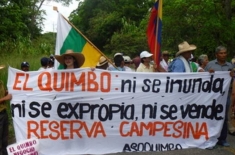Il controverso progetto El Quimbo in Colombia
El Quimbo è una centrale idroelettrica costruita dalla multinazionale italo-spagnola Enel-Endesa, attraverso Emgesa. Situata nella Provincia di Huila nel Sud della Colombia è il secondo impianto di questo tipo per grandezza in Sud America. È costituita da una diga di 151 metri di altezza e di 632 metri di lunghezza sul fiume Magdalena. Vi è inoltre una diga ausiliaria di altezza 66 metri e lunghezza 390 metri. Tale opera comporterà l’ inondazione di 8.500 ettari di terre agricole. La costruzione è iniziata nel 2011 ed è stata fin dall’inizio al centro di controversie per i suoi gravi impatti ambientali e socio-economici e culturali tra cui :la distruzione di foreste e habitat che ospitano specie protette, la distruzione delle popolazioni ittiche a causa della deviazione del fiume Magdalena, la contaminazione del fiume, l’aumento del rischio sismico, l’inondazione di terre destinate all’allevamento di bestiame e perdita di terre fertili ad alta produttività che metterebbe a rischio la sicurezza alimentare dell’intero Dipartimento di Huila, lo sfollamento di 467 famiglie attualmente residenti nell’area da inondare, la perdita del patrimonio archeologico ( nella zona coinvolta dal progetto sono state identificate 78 aree di interesse archeologico di epoca pre-ispanica), l’inondazione della cappella di San José de Belén dichiarata patrimonio culturale del Dipartimento di Huila. Le famiglie che sono state sfollate sono state reinsediate in terre meno fertili e hanno trovato poche opportunità di lavoro oltre alla difficoltà nel riprendere le loro attività di pesca e agricoltura. Proprio per far fronte a tali impatti negativi e a febbraio 2015 il Tribunale amministrativo del Huila aveva ordinato la sospensione del riempimento dell’invaso . Pochi mesi dopo però con un decreto di emergenza, il presidente Juan Manuel Santos aveva autorizzato la ripresa dei lavori. La misura però non ha convinto la Corte costituzionale ha ordinato la sospensione delle operazioni di El Quimbo e il rispetto delle misure cautelari decise dal Tribunale del Huila.
Location
Environmental impact
- Water pollution
- Biodiversity loss – Ecosystem destruction
- Depletion of natural resources (fossil and mineral, forest, water, etc)
- Alteration of landscape aesthetics and built heritage
Ethical/ legal issues
- Health and well-being
- Equality before the law and protection by the law (including marginalized and discriminated groups because of colour, race, gender, disability, descent, economic status, age, etc.)
- Indigenous land, culture and rituals
- Access to public goods/ resources and products
- Democratic participation to decision-making on community and national affairs
Information sources & materials
Online books and newspaper, magazine, encyclopedia, or blog articles
https://colombiareports.com/160809-2/
https://www.internationalrivers.org/blogs/436/the-many-faults-of-el-quimbo-dam
http://www.recommon.org/diga-di-el-quimbo-in-colombia-uneccellenza-nefasta/
http://www.qcodemag.it/2017/03/08/la-resistenza-e-vita/
http://cdca.it/archives/12210
Contributor(s)
Elisa Veritti, elisa.veritti@gmail.com, CeVI, Italy



Home › Forums › El Quimbo hydroelectric power plant in Colombia